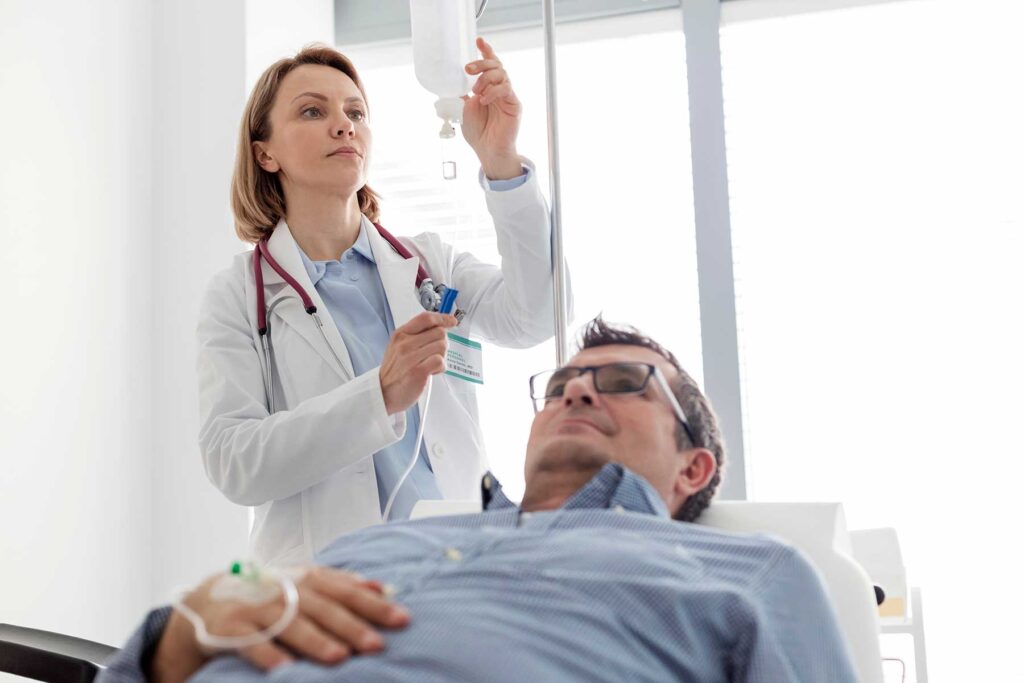The conventional treatment for opioid addiction is medically assisted detox, which, unfortunately, substitutes one legal, FDA-approved narcotic for an illegal one but doesn’t restore the addicted brain. According to the FDA’s commissioned report, “Methadone is a long-term substitute for addictive drugs and becomes a replacement drug because it does not alleviate the root cause of the addictive behavior – the craving for drugs or alcohol.”
Indeed, all three of the FDA-approved drugs for treating opioid dependence (buprenorphine, methadone, and naltrexone) are narcotic agonists, sending users into withdrawal within hours of their last dose. And all three are difficult to quit.
Medically Assisted Detox Withdrawal Symptoms
Withdrawal from medically-assisted treatment narcotics, such as Suboxone, which combines buprenorphine and naloxone, can include:
- Restlessness
- Hot or cold flashes
- Runny nose
- Teary eyes
- Nausea
- Fatigue
- Muscle or bone aches
- Over the next few days, additional flu-like symptoms may develop, including:
- Nausea and vomiting
- Diarrhea
- Depression
- Anxiety
- Agitation
- Irritability
- Sweating
- Insomnia
At Springfield Wellness Center, our patients who have detoxed from Suboxone and methadone say that these drug detoxes are very difficult and that our intravenous NAD treatment is the only thing that has gotten them through it.
Are There Alternatives to Medical Detox?
The medical profession’s reliance on medication-assisted treatment (MAT) would perhaps be justifiable if no alternative were available. But that is not the case. For the last 20 years, we at Springfield Wellness Center have demonstrated that there is a safe, effective alternative: intravenous NAD.
NAD (nicotinamide adenine dinucleotide) is a natural precursor of Vitamin B3 that is essential to many cellular processes. It is non-addictive, and there are no withdrawal symptoms or cravings from the cessation of use.
Unfortunately, however, NAD levels naturally decline with age and various stressors—including illness and substance use.
Because NAD performs so many vital bodily roles, it is uncertain which are critical to addiction detox. However, we believe that intravenous NAD helps to reset the mid-brain, where addiction occurs. Intravenous NAD also helps to improve thinking and cognitive functioning, which is vital to maintaining sobriety long-term. From our own experience administering intravenous NAD, we can say that this process:
- Helps the body rid itself of addictive substances.
- Reduces or eliminates withdrawal symptoms, which can be extremely difficult to tolerate.
- Substantially reduces cravings and lessens the pain of withdrawal, both physically and mentally.
- Supports the body’s natural energy-producing functions, DNA repair, and immune functions.
These results are confirmed by the American Addiction Foundation, which reports that NAD “binds to opioid receptors and reduces withdrawal symptoms. It replaces the vitamins and minerals which have been depleted from substance abuse. It improves brain function and acts as an antidepressant. It greatly helps to repair and restore your body from the damage caused by addiction and also helps counter the depression and mood swings associated with post-acute withdrawal syndrome. It reduces cravings and eases the pain of withdrawal.”1
More Evidence of Effective Alternatives
Moreover, these results are often experienced in just a few days of outpatient treatment. Although we prescribe 10 to 12 days of IV NAD treatment at Springfield Wellness Center to fully detox from opioids, most patients report no cravings after Days 3-5. The additional days of treatment work primarily to restore clarity and more normal brain functioning. After the initial treatment, patients can return for a one-day booster if they are going through a period of abnormal stress or feel the cravings start to return.
The Summary Report on Nicotinamide adenine dinucleotide prepared by the University of Maryland for the FDA, reported that: “NAD was nominated for use in the management of fatigue, Alzheimer’s disease, and detox and withdrawal relating to addiction via 20-250 mg/mL and 250- 1200 mg intravenous (IV) and subcutaneous injections and oral products. Nominators provided references from published peer-reviewed literature to describe the pharmacology and support the clinical use of NAD.
“Reasons provided for nomination [of NAD] to the 503B Bulks List included:
- There are no FDA-approved formulations of NAD.
- Existing FDA-approved drugs have greater side effects, have more interactions when taken with other drugs, and may be less effective.
- Methadone is a long-term substitute for addictive drugs and becomes a replacement drug because it does not alleviate the root cause of the addictive behavior – the craving for drugs or alcohol.
- Compounded NAD may be the only product to effectively treat the indication for which it is intended.”2
One subject matter expert was quoted saying that “addiction psychiatry meds are a Band-aid for the problem,” and NAD is the first treatment that they have seen that is a restorative therapy. The author’s concluding statements recommended using NAD to treat drug or alcohol addiction.
Why Do People Try Medication-Assisted Treatment?
So why would anyone turn to Suboxone, methadone, or another narcotic to quit their addiction to opioids?
The primary reasons are cost and lack of public awareness. While many health insurers cover medically-assisted treatment, our treatment has yet to be. So, until the day that studies like the Summary Report on Nicotinamide adenine dinucleotide can convince the medical establishment—starting with the FDA—that intravenous NAD can—and should—be the standard treatment for addiction detox—and covered, accordingly, by health insurers, patients are left to pay for the treatment itself.
Although the current $15,000 price tag for opioid addiction detox is beyond the reach of many, these costs should be assessed in the context of the following facts:
- Financing is (and some scholarships are) available.
- $15,000 is far less than conventional 60- to 90-day addiction rehab (albeit these costs must be borne privately).
- Detoxing with brain restoration in mind is generally cheaper than detoxing more than once (first from the original substance and then from the replacement medication).
- Getting one’s life and health back—free from addiction—is priceless. The cost of addiction far exceeds the cost of any treatment—especially when considering the cost of DUI, divorce, job loss, respiratory arrest, early death, or any other consequences of long-term narcotics use.
In short, intravenous NAD detox treatment is a compelling alternative to medically-assisted detox and should be seriously considered when choosing a detox method.
Call Springfield Wellness Center Today
If you or a loved one is struggling with addiction symptoms, Springfield Wellness Center is here to help. We provide NAD infusions and mental health treatment to help people recover from substance use disorders. Call 844.334.4727 today or visit our website to learn how we can help you start feeling better tomorrow.
Footnotes:
American Addiction Foundation – “NAD: Holistic Treatment for Alcohol, Nicotine and Opioid Addiction”


